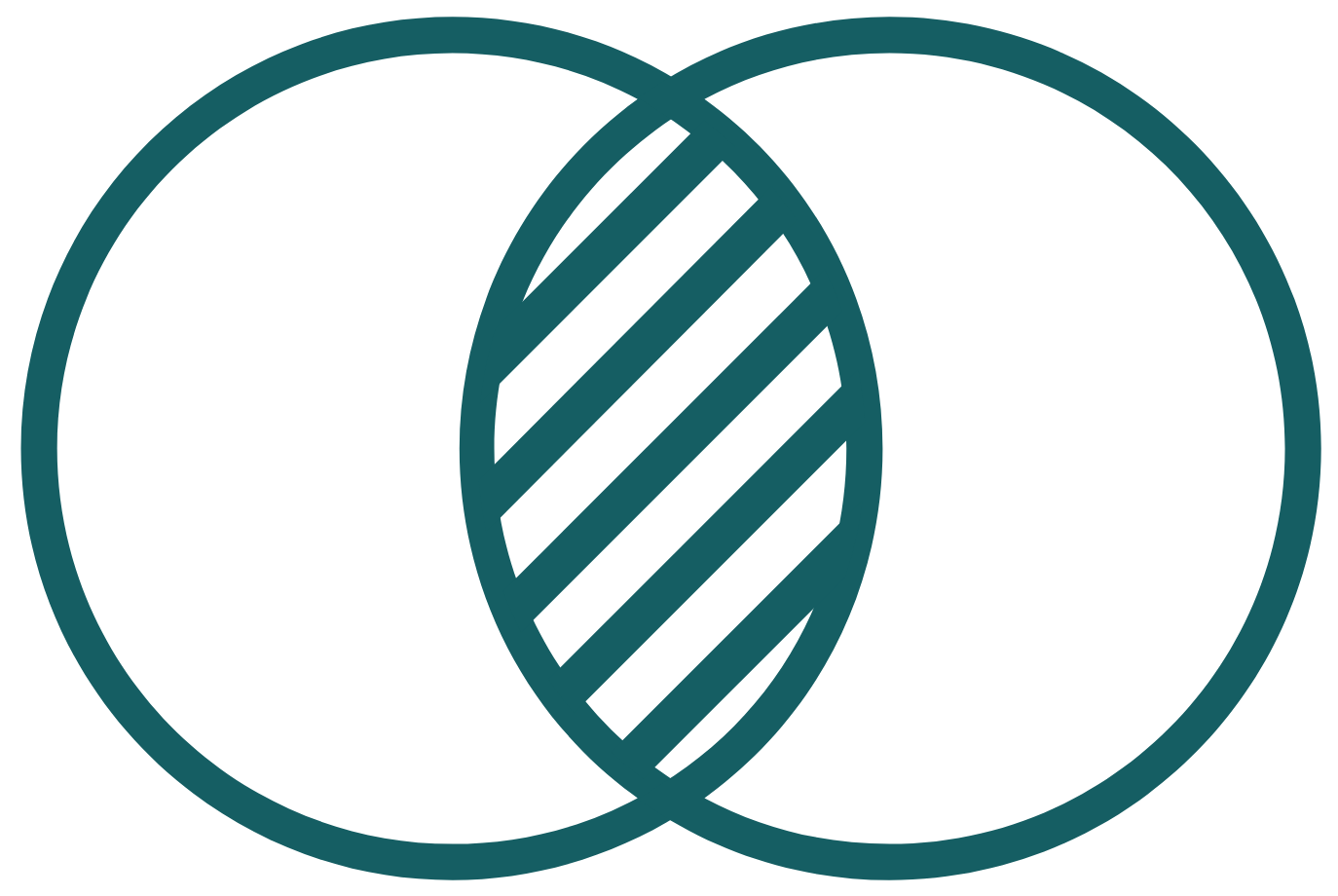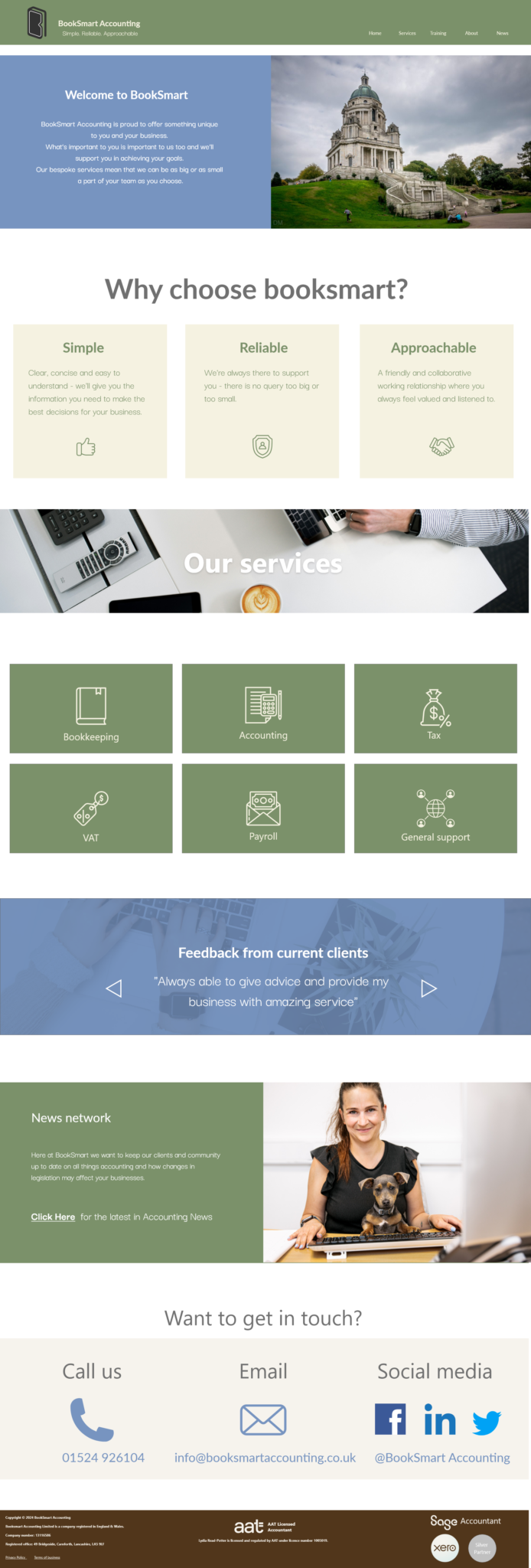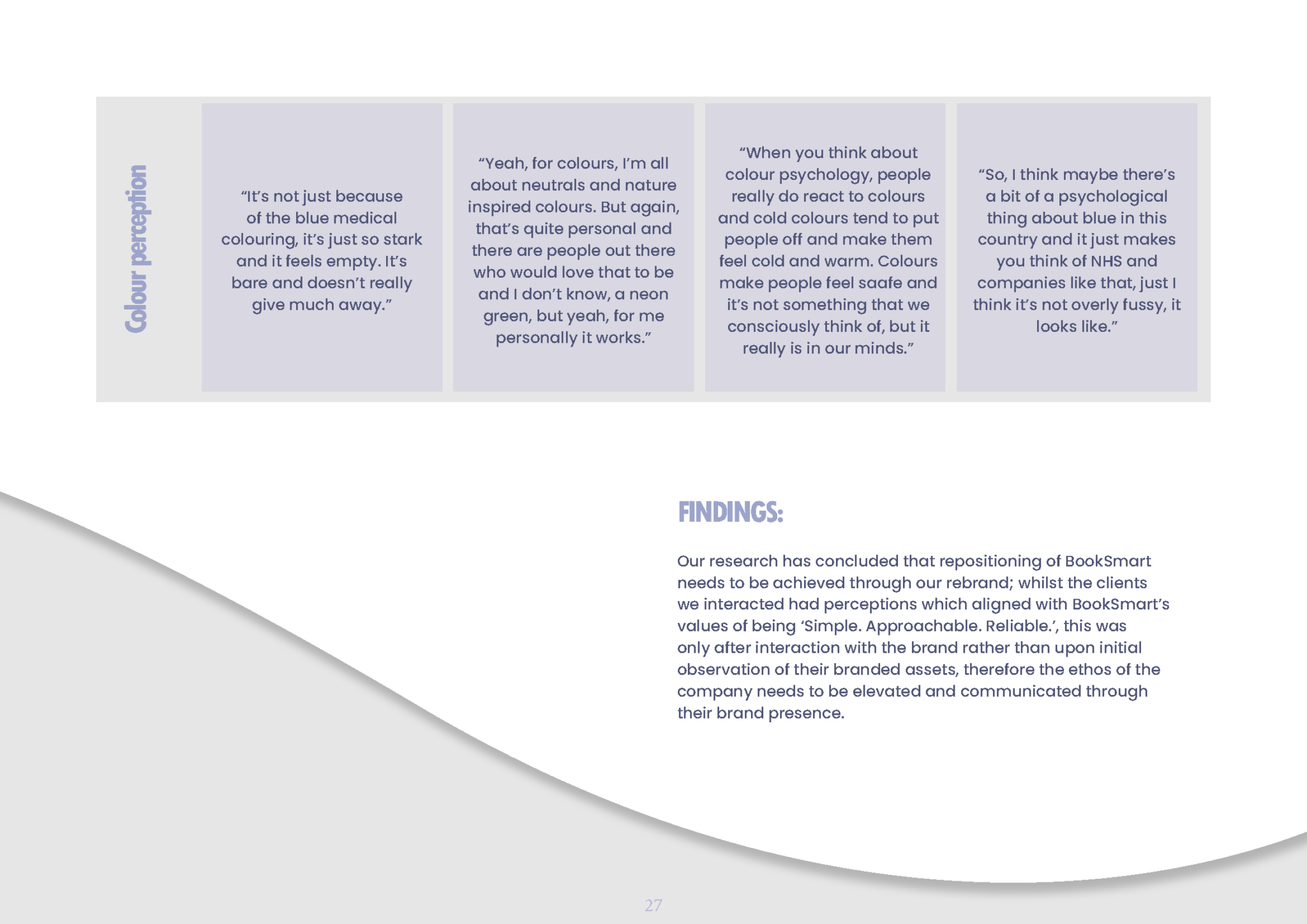BookSmart
A consultancy rebrand project

Due to rapid growth, BookSmart have been unable to dedicate time to develop a comprehensive rebrand which aligns with their values and unique approach to accountancy. My client believed their existing branding did not communicate and convey their approachability, and capabilities to develop strong relationships with their clients.
Furthermore, due to the initial small scale of the company when the brand was established, the client found themselves becoming the figurehead of their business. As growth has been achieved over time Lydia, Booksmarts founder, wishes to establish BookSmart as a corporate brand separate from her identity. The new identity is to be established and encapsulate the core values of the brand.
As part of this consultancy project I had to work within a team of 5, each taking on a respective role. Early into the project I took on the role of project lead, ensuring all research and deliverables are produced along the project timeline we established at the start of the project.

To allow BookSmart’s personality to be conveyed, we established four key objectives to address throughout different elements of our rebrand project:
♦ Identify and convey the unique selling points of BookSmart accounting, from both client and consumer perspective.
♦ Identify and rectify errors within BookSmart’s existing branding.
♦ Identify and target BookSmart’s target clientele through rebranded assets.
♦ Produce a consistent rebrand through the following elements: colour scheme, typography, logo, website, and social media assets.
Research Questions
Secondary Research
Competitor analysis:
To conduct a competitor analysis in relation to the proposed deliverables, we compared relevant branding materials produced by both direct (regional) and indirect (national) competing accountancy firms. By conducting a competitor analysis, as project lead, our team was able to observe patterns within the chosen branding of accounting firms. Consequently this provided a guidance as to how BookSmarts branding could be enhanced through our rebrand.
Website Audit:
The primary objective of the website audit is to establish areas of improvement in aspects such as navigation, along with ensuring the full use of marketing potential. A professionally produced website will enhance the competitiveness of the brand. Conducting the audit
allowed for the comparison between BookSmart’s website and the identified competitors, establishing strengths and weaknesses which aided recognition of potential benefits and pain points use may bring to consumers.
Primary Research
Client Ethnography:
Ethnography was the first step within primary research to gain first-hand understanding of BookSmart’s culture by overtly observing operations within the workplace. The insight into their culture corroborated the values we were informed of prior and ensured we could effectively communicate these through the rebrand.
Conducting ethnography provided a first-hand understanding of our client, regarding their environment, offering, and alignment with company values. We were able to establish their tone of voice, which was friendly and conversational within client interactions and demonstrated through their workplace environment which mimics that of a close family; upon observation, BookSmart are a tight knit community which act as a lifeline for their clients, evident of clients who told the employees that they “saved their life” during the observation.
Evidently, BookSmart have achieved the criteria of reliability through their work, their care for their client extending beyond accounting proving to be a key selling point that we wish to establish as a core principle and communicate within the rebrand. Conducting the ethnography further granted the opportunity to establish a closer relationship with our client, which has proven detrimental whilst acquiring participants for further research.
Client Personas:
To gain insight into BookSmart’s target clientele, we collaborated with BookSmart to develop personas reflective of the target audience, considering their typical interests, influences, goals, motivations, needs, expectations, and any potential pain points they could experience whilst using BookSmart’s services to ensure we are addressing and resolving these considerations within our rebrand.
To deliver these, we arranged an interview with the founder of BookSmart to identify their target clientele; from this, we derived that they wished to target an entrepreneurial client, typically acting as CEO of a company, who want to grow their business, have a passion to learn, and willingness to have high involvement with BookSmart.
We developed conceptual personas before conducting research with BookSmart’s clients to ensure we selected participants who were representative of the target audience within our research methods to ensure the insights which were aiding our branding decisions were reflective of the desires of the target audience.

User Journey Mapping:
Within our user journey mapping, we discussed different user actions, touch points, emotions, and paint points that would occur within different stages of the user journey, consisting of awareness, consideration, purchase, service, loyalty, and advocacy. The user journey followed the journey of BookSmart’s ideal client based on the character persona previously formed. By constructing the user journey, we were able to form potential perceptions clients have during their experience with BookSmart as a service, allowing us to construct the questions used within our research on the basis of these likely perceptions so that the participant has a greater probability of being able to relate and engage in our research.
After constructing the user journey, supported by the personas previously constructed and consultation with BookSmart, we concluded the central pain point arising during the user journey regarding branding and communication appears to be uninteresting or inconsistent content and/or BookSmart not providing an overt opportunity for clients to provide feedback or voice concerns surrounding service satisfaction. This in turn would severely limit BookSmart’s opportunity for growth. However, the pain points a client may encounter are minimal due to the direct contact process BookSmart have adopted, implying that this benefit should be emphasised within their rebrand.
Client Questionnaire:
Our main objective of using a questionnaire was to gauge an overall understanding of existing client perceptions of BookSmart Accounting and their existing branding. By exploring these perceptions, we aim to understand what elements of the BookSmart brand were working for clients, identify errors within BookSmart’s existing branding, and opportunities to improve. Our aim was to gain initial insight into client’s existing perceptions of BookSmart and their current branding, based on their existing clients. BookSmart has a good relationship with their clients, so it felt wise to use this to an advantage to fully understand what drew them to BookSmart.
Using a questionnaire to understand BookSmart’s clients’ perceptions meant that we were able to ask specific questions and allow them to express themselves freely, providing an efficient way of gathering honest information, due to the lack of observation, from a range of clients. The accessibility of the questionnaire provided a way to collect relevant information for our project and provided interpretable, comparable data.
Online Workshop:
To consolidate our research and build on the overview of perceptions received from the questionnaire, we conducted two online workshops with one client each to gain indepth insight into target clients’ perceptions of branding elements and their personal preferences as business owners which would be applicable to BookSmart. Utilising a one-to-one interview, we gained insight into client styles and what experience had constructed such perceptions of BookSmart. Each workshop served a different objective, tailored to understand clients from diverse perspectives. The interview session involved both word-associating inquiries and unusual questions to encourage out-of-the-box thinking. The card-sorting activity was intended to be the core of the workshop, requiring high participant engagement and allowing us to identify what’s most important to the people you’re designing for.
Participants categorising branding elements involved in the rebrand independently to understand their related perspectives and preferences. Whilst the card-sorting activity has been deemed unapplicable to our branding considerations due to inconsistencies within completion between participants, we were able to prompt in depth responses regarding colour, logo, aesthetics, social media, and websites, alongside a one-to-one interview in the duration of the workshop. Upon analysis, we coded the transcript from the workshops and identified seven key themes which emerged regarding branding preferences:
♦ Accessibility: Participants prioritised being easily to locate the information required.
♦ Clarity: Ability to identify and recognise branded assets and necessary information.
♦ Educational Contents: Due to the complexity of accounting, clients appreciated simplified information to gain understanding of their finances and gain independence.
♦ Recognisability & Identity: Clients would like an identity for BookSmart which differentiates them from other accounting companies and is reflective of their unique values.
♦ Welcoming & Friendly Image: The general associations with accountancy were that it was a mundane business, therefore clients value differentiation with companies which appeared inviting and welcomed feedback
♦ Colour Perception: Many respondents disliked the clinical associations with the blues used in most accounting firms and would prefer neutral/ warmer tones which implied friendliness.
♦ Purposeful Design: Clients showed preferences towards interactive design which was personal to the company to humanise the brand.
Interview Quotes


Research Limitations
Limited Questionnaire Response: Generalisability
BookSmart Accounting boast a clientele of 300+, yet our questionnaire received 25 responses, representative of around 8% of their client base, therefore, generalisability comes into question, and we cannot be certain that our results are reflective of all BookSmart’s clientele’s attitudes. Consequently, we will continue with the application of the research emphasising the client profiles provided through interviews with Booksmart Accounting when producing the final materials.
Research Inconsistencies
During the card sorting task within the workshop, there was inconsistency in completion of the task between both participants, which has led to a limitation of data analysis. There has been slight similarity between the way they grouped branding elements and the naming of themes, however, both participants forgone to categorise all items and justified their reasonings verbally rather than visually. This may be due to the duration of the task or due to the participants’ unfamiliarity with Miro (chosen interactive platform).
Low Incentives for Workshop Participation
Our initial plan involved conducting an in-person workshop with 5-10 participations so data generated could be supported by observations and interactions. As a student-led research initiative, we encountered challenges in recruiting participants without offering incentives due to BookSmart having limited funds. Consequently, we had to adapt our approach and conduct two online workshops with one participant each. This adjustment significantly restricted our sampling frame and therefore scope of our data collection, limiting depth of insights and possibility to research potential clients.
Key learnings
Lorem ipsum dolor sit amet, consectetur adipiscing elit. Ut elit tellus, luctus nec ullamcorper mattis, pulvinar dapibus leo.Lorem ipsum dolor sit amet, consectetur adipiscing elit. Ut elit tellus, luctus nec ullamcorper mattis, pulvinar dapibus leo.
Lorem ipsum dolor sit amet, consectetur adipiscing elit. Ut elit tellus, luctus nec ullamcorper mattis, pulvinar dapibus leo.Lorem ipsum dolor sit amet, consectetur adipiscing elit. Ut elit tellus, luctus nec ullamcorper mattis, pulvinar dapibus leo.
Lorem ipsum dolor sit amet, consectetur adipiscing elit. Ut elit tellus, luctus nec ullamcorper mattis, pulvinar dapibus leo.Lorem ipsum dolor sit amet, consectetur adipiscing elit. Ut elit tellus, luctus nec ullamcorper mattis, pulvinar dapibus leo.
Research goals
 Timeline
Timeline
October 2023 – March 2024
Role
Project Lead and UX/UI Designer
Background
Loreum ipsumLoreum ipsumLoreum ipsumLoreum ipsumLoreum ipsumLoreum ipsumLoreum ipsumLoreum ipsumLoreum ipsumLoreum ipsumLoreum ipsumLoreum
Loreum ipsumLoreum ipsumLoreum ipsumLoreum ipsumLoreum ipsumLoreum ipsumLoreum ipsumLoreum ipsumLoreum ipsumLoreum ipsumLoreum ipsumLoreum
Challenges
Loreum ipsumLoreum ipsumLoreum ipsumLoreum ipsumLoreum ipsumLoreum ipsumLoreum ipsumLoreum ipsumLoreum ipsumLoreum ipsumLoreum ipsumLoreum
Loreum ipsumLoreum ipsumLoreum ipsumLoreum ipsumLoreum ipsumLoreum ipsumLoreum ipsumLoreum ipsumLoreum ipsumLoreum ipsumLoreum ipsumLoreum
Early stages
Loreum ipsumLoreum ipsumLoreum ipsumLoreum ipsumLoreum ipsumLoreum ipsumLoreum ipsumLoreum ipsumLoreum ipsumLoreum ipsumLoreum ipsumLoreum
Loreum ipsumLoreum ipsumLoreum ipsumLoreum ipsumLoreum ipsumLoreum ipsumLoreum ipsumLoreum ipsumLoreum ipsumLoreum ipsumLoreum ipsumLoreum
Key learnings
Lorem ipsum dolor sit amet, consectetur adipiscing elit. Ut elit tellus, luctus nec ullamcorper mattis, pulvinar dapibus leo.Lorem ipsum dolor sit amet, consectetur adipiscing elit. Ut elit tellus, luctus nec ullamcorper mattis, pulvinar dapibus leo.
Lorem ipsum dolor sit amet, consectetur adipiscing elit. Ut elit tellus, luctus nec ullamcorper mattis, pulvinar dapibus leo.Lorem ipsum dolor sit amet, consectetur adipiscing elit. Ut elit tellus, luctus nec ullamcorper mattis, pulvinar dapibus leo.
Lorem ipsum dolor sit amet, consectetur adipiscing elit. Ut elit tellus, luctus nec ullamcorper mattis, pulvinar dapibus leo.Lorem ipsum dolor sit amet, consectetur adipiscing elit. Ut elit tellus, luctus nec ullamcorper mattis, pulvinar dapibus leo.

Research goals
Timeline
October 2023 – March 2024
Role
Project Lead and UX/UI Designer
Background
Loreum ipsumLoreum ipsumLoreum ipsumLoreum ipsumLoreum ipsumLoreum ipsumLoreum ipsumLoreum ipsumLoreum ipsumLoreum ipsumLoreum ipsumLoreum
Loreum ipsumLoreum ipsumLoreum ipsumLoreum ipsumLoreum ipsumLoreum ipsumLoreum ipsumLoreum ipsumLoreum ipsumLoreum ipsumLoreum ipsumLoreum
Challenges
Loreum ipsumLoreum ipsumLoreum ipsumLoreum ipsumLoreum ipsumLoreum ipsumLoreum ipsumLoreum ipsumLoreum ipsumLoreum ipsumLoreum ipsumLoreum
Loreum ipsumLoreum ipsumLoreum ipsumLoreum ipsumLoreum ipsumLoreum ipsumLoreum ipsumLoreum ipsumLoreum ipsumLoreum ipsumLoreum ipsumLoreum
Early stages
Loreum ipsumLoreum ipsumLoreum ipsumLoreum ipsumLoreum ipsumLoreum ipsumLoreum ipsumLoreum ipsumLoreum ipsumLoreum ipsumLoreum ipsumLoreum
Loreum ipsumLoreum ipsumLoreum ipsumLoreum ipsumLoreum ipsumLoreum ipsumLoreum ipsumLoreum ipsumLoreum ipsumLoreum ipsumLoreum ipsumLoreum
Key learnings
Lorem ipsum dolor sit amet, consectetur adipiscing elit. Ut elit tellus, luctus nec ullamcorper mattis, pulvinar dapibus leo.Lorem ipsum dolor sit amet, consectetur adipiscing elit. Ut elit tellus, luctus nec ullamcorper mattis, pulvinar dapibus leo.
Lorem ipsum dolor sit amet, consectetur adipiscing elit. Ut elit tellus, luctus nec ullamcorper mattis, pulvinar dapibus leo.Lorem ipsum dolor sit amet, consectetur adipiscing elit. Ut elit tellus, luctus nec ullamcorper mattis, pulvinar dapibus leo.
Lorem ipsum dolor sit amet, consectetur adipiscing elit. Ut elit tellus, luctus nec ullamcorper mattis, pulvinar dapibus leo.Lorem ipsum dolor sit amet, consectetur adipiscing elit. Ut elit tellus, luctus nec ullamcorper mattis, pulvinar dapibus leo.








